In a village in La Mancha … Almagro
Although we weren’t riding horses, our trip was reminiscent of an adventure with Don Quixote and Sancho Panza – along deserted paths between vineyards and grain fields, past the windmills of La Mancha silhouetted on an endless horizon.
Our travels took us to Almagro, the site of a cultural treasure that is definitely worth a visit: the Corral de Comedias. This is the only theatre left intact from the Spanish Golden Age and it is still used today for stage productions. The town of Almagro is situated about 125 miles south of Madrid in the Spanish province of Ciudad Real.
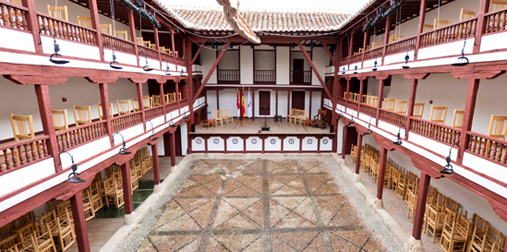
Strolling through the cobblestone streets, the air is filled with history every step of the way. The atmosphere makes it easy to look back four centuries and imagine the noble families, farmers, merchants and landowners who lived here. This city was once the home of the Order of Calatrava and many of the order’s mansions, monasteries and palaces have been well preserved.
The winding streets of Almagro lead us to the Plaza Mayor in the town center. Emerald green glass galleries above Tuscan porticos flank two sides of the plaza in an architectural style that is unique in Central Europe and Spain. The town hall at one end of the square faces a landscaped garden with a statue of Don Diego de Almagro at the other end. A Spanish conquistador in Peru and Chile, Almagro was the first European to land in Bolivia.
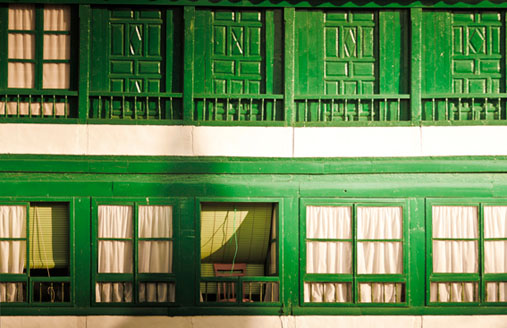
We were eager to find the main attraction on the square, the Corral de Comedias. Situated in the courtyard of a plebeian house, the Baroque theatre was built by Leonardo de Oviedo in 1628. Back in those days, comedy was the word used to describe all secular theatre pieces. Of course plays from other genres were also performed here, including works by Lope de Vega, Tirso de Molina and Mateo Alemán.
The word “Almagro” comes from Arabic and means reddish clay. This is the color of the 54 wooden loges on the two upper levels of the theatre. In a region blessed with generous amounts of sunshine, the whitewashed walls create a natural lighting that brings the stage to life.
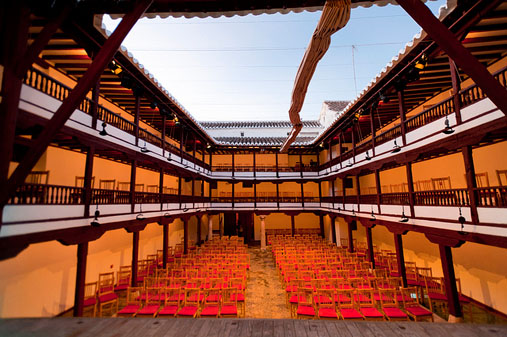
In Spain’s culturally-rich Golden Age, the courtyards of the houses and restaurants served as places where different social classes enjoyed entertainment – together, but never mixed. In the courtyards, beneath the stone arches, less wealthy men – “Mosqueteros” – watched the show. Their applause or critical whistling determined the success or failure of the dramatic presentations – which usually lasted for up to four hours.
Upper class citizens sat on both sides of the galleries. Seats on the upper level were reserved for members of the aristocracy, who could watch the play without being seen. Women were typically seated in the “cazuelas,” the center galleries offering a direct view of the stage.
July is a good month to visit Almagro. This is when the annual Festival Internacional de Teatro Clásico takes place on no less than 16 historical stages.
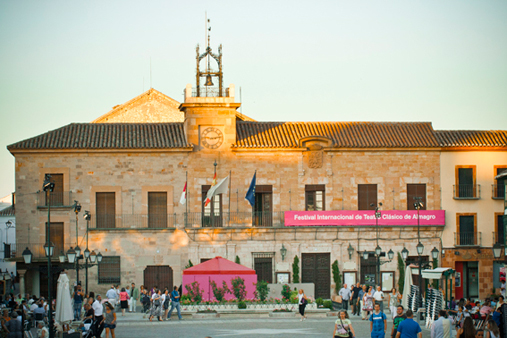
Along St. Augustine, one of the main streets leading into town, we see a woman sitting on the ground nimbly working with needles and different yarns. She’s making lace be needlepoint, a tradition handed down from mother to daughter over the centuries. Only the customers have changed. Today, the unique handwork is typically purchased by tourists from all over the world.
We need not visit the “Museo del Encaje y Blonda” lace museum. The collections of Señora María and her sister, accompanied by wonderful tales, seem like a museum to us. According to these ladies, lace making in Almagro started with the arrival of Flemish settlers from the Netherlands and dates back to Carlos I. However, it is pointed that this craft was mentioned prior to the 16th century according to the writings of Cervantes.
Almagro has been declared an art-historical heritage site – and this comes as no surprise when you see the magnificent gates of the Convento de la Asunción de Calatrava monastery, or the palaces of the Marquis of Torremejía and the Earl of Valdeparaíso.

Following a delicious lunch break with Manchego cheese, aubergines from Almagro and a glass of wine from the region, we cross Federico Relimpio, the street where Pedro Almodóvar shot the film “Volver.” After completing the last film scene, Almodóvar wrote:
“I love the barrenness of these streets, the cobblestones, the windows with iron gratings, devoid of flower pots or decorations of any kind. The dark foundations, the intense daylight…”
We have reached the end of our journey, but we’ll be back!
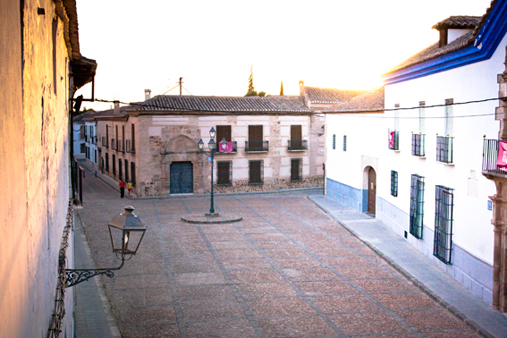
María Luz Moraleda was born on August 26, 1988 in Herencia, La Mancha. She studied Journalism and audiovisual communication at the University Carlos III in Madrid and at the University of Central Lancashire, England. She has lived and worked in Berlin since September 2012.


